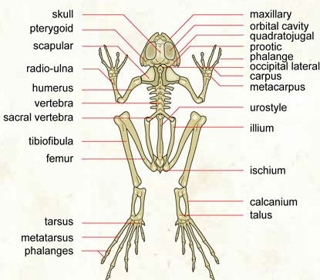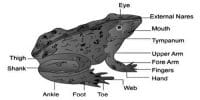The axial skeleton is situated along the mid dorsal line of the body and is formed by the combination of skull and vertebral column. The axial skeleton is extended from the anterior end of the head to the posterior end of the body.
Skull: The part of the axial skeleton which forms the frame of the head and protects the brain is called skull. It consists of various small and large bones. A skull has different parts, such as cranium, upper jaw, lower jaw, nasal, capsule eye cavity, ear cavity, hyoid apparatus etc.

The small cavity at the middle of the head surrounded by small bones, in which the brain lies, is called the cranium. At the posterior part of the cranium there is a big aperture called foramen magnum. Through this opening the spinal cord comes out from the brain and enters the vertebral column. At the floor of the buccal cavity of the toad, there lies a plate like structure made of cartilage called hyoid apparatus. Upper and lower jaws surround the mouth aperture. The upper jaw is firmly attached with the cranium but the lower jaw can move up and down. In the wall of the cranium there are several paired pores. Through these pores the cranial nerves from the brain comes out.
Functions of skeleton: The skeleton does the following functions:
- It gives structure and firmness to the body- The skeleton forms the hard structure of the body and gives it a definite shape.
- It protects soft organs – The skeleton protects the important soft organs of the body such as, heart, lungs, brain, etc.
- It stores fat and produces blood corpuscles- White bone marrow stores the fat and red bone marrow produces the red blood corpuscles.
- It helps in the attachment of muscles- Skeleton forms the surface for the attachment of muscles, muscle ligaments and mesenteries and helps in keeping the various organs of the body in definite positions.
- It carries the weight of the body and assists in locomotion-The coordination of skeleton an skeletal muscles helps in carrying the weight and movement of the body.













